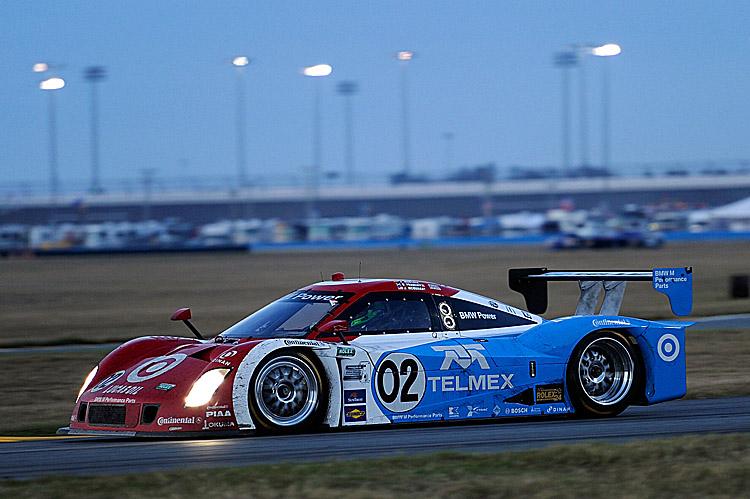The final eight hours of the 50th Anniversary Grand Am Rolex 24 at Daytona was developing into an endurance racing fan’s fantasy.
True there were only three cars on the lead lap—but all three were contending for the lead, and of the cars a few laps back, any could compete if anything happened to the leaders.
Three Daytona Protoypes—the #60 Shank Racing Riley-Ford, the #8 Starworks Riley-Ford, and the #01 Telmex-Ganassi Riley-BMW had all finished 518 laps as the clock struck 8 a.m. Lucas Luhr in the Starworks car had just set a new fast lap on lap 497, 1:41.470 at 126.303 497 mph, besting the mark of 1:41.473 at 126.299 set by Shank Racing’s Justin Wilson on lap 486, five laps before he wrested the lead from Ryan Dalziel, who was just finishing his stint in the Starworks Riley-Ford.
That’s right—after 16 hours of racing, cars were still racing, still going all-out for position. Through the night Starworks and Shank Racing battled through the night, first Allan McNish versus AJ Allmendinger, then Ryan Dalziel versus Justin Wilson, then Wilson versus Lucas Luhr—all national and international racing stars, using all their talents, all night long. Starworks held the lead through most of the night, fighting off the Shank car.
When Justin Wilson got in the Shank car at 6:23 a.m., it took him only 45 minutes to get by Ryan Dalziel to take the lead. Dalziel didn’t accept his demotion; he took off chasing, and he needed to, because Graham Rahal in the #01 Telmex-Ganassi car was right on his rear wing.
Just after 8 a.m. the leaders pitted. Joey Hand took over from Graham Rahal, and also took over second place. As the 17-hour mark approached, the three were still at it, with Wilson increasing his lead, Joey Hand hot after him, and Lucas Luhr trying to get his position back.
After hours of blazing laps, Luhr lost his concentration for an instant—at the worst possible instant, as the car entered the Bus Stop chicane. The subsequent contact tore the tail off the car, and the necessary repairs dropped it two laps. A perfect example of the idea that in an endurance race, anything can happen at any time.
This is 21st-century endurance racing. No more nursing the car through the night hoping it would be running at sunrise. Nowadays the cars are built strong enough to go flat-out for 24 hours, and that is how they are driven. This is endurance racing for adrenaline junkies; fans who choose to go to bed early know they will probably miss a lot of exciting action.
One other factor that helped keep the race exciting was the paucity of yellow flags: only ten full-course cautions in the first 17 hours, with green-flag runs of over 100 laps. Knowing there might not be any more cautions, teams which might have waited for an accident to bunch up the field, instead had to make up time on the track.
17 hours into the race seven cars were within two laps of the leader: the Two Starworks Riley-Fords, the two Shank Racing Riley-Fords, both Telmex-Ganassi Riley-BMWs, and the #5 Action Express Corvette-Coyote. With seven hours of racing still to come, any of these Daytona Prototypes still have a serious chance for a podium or an overall win.







